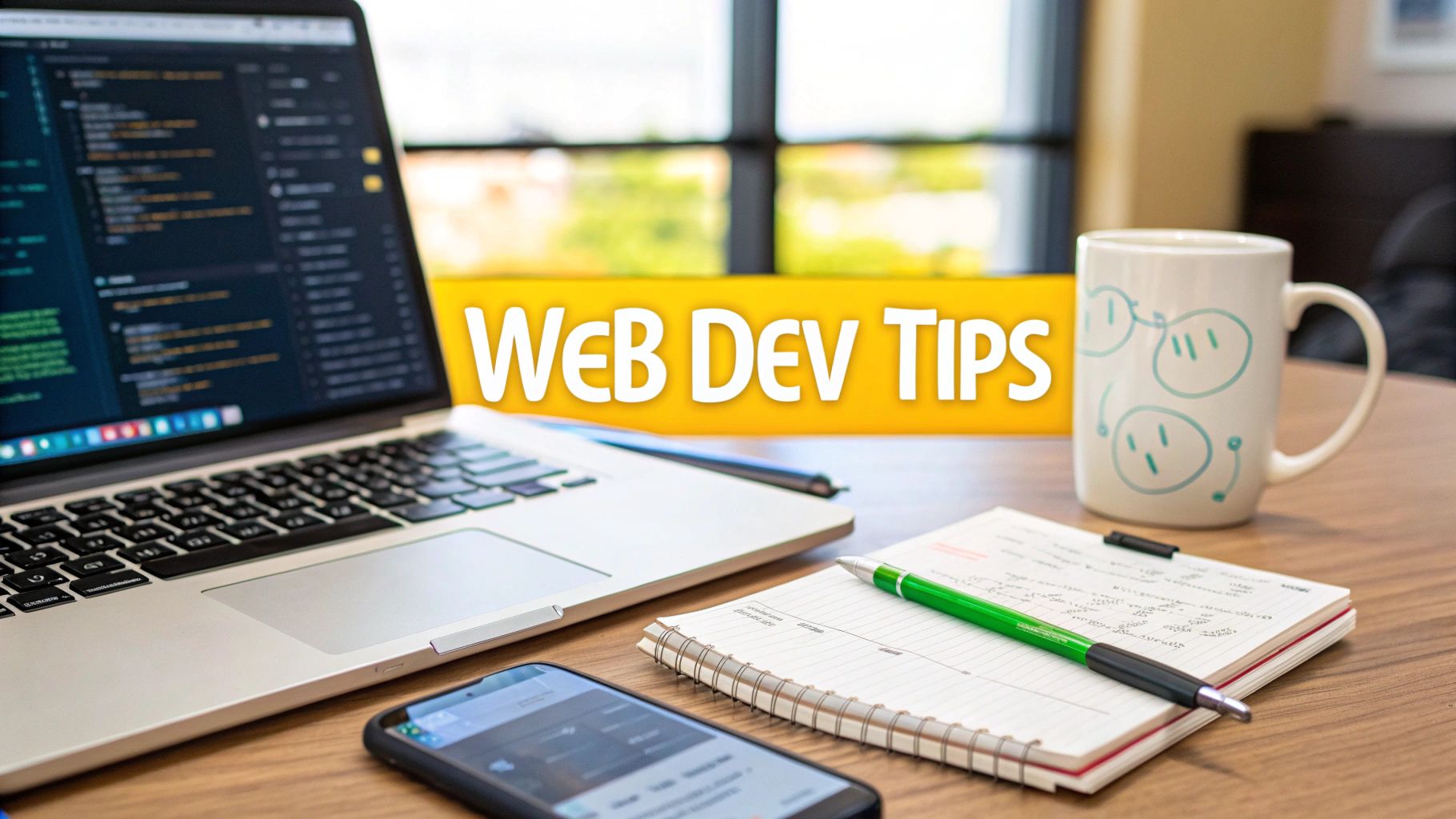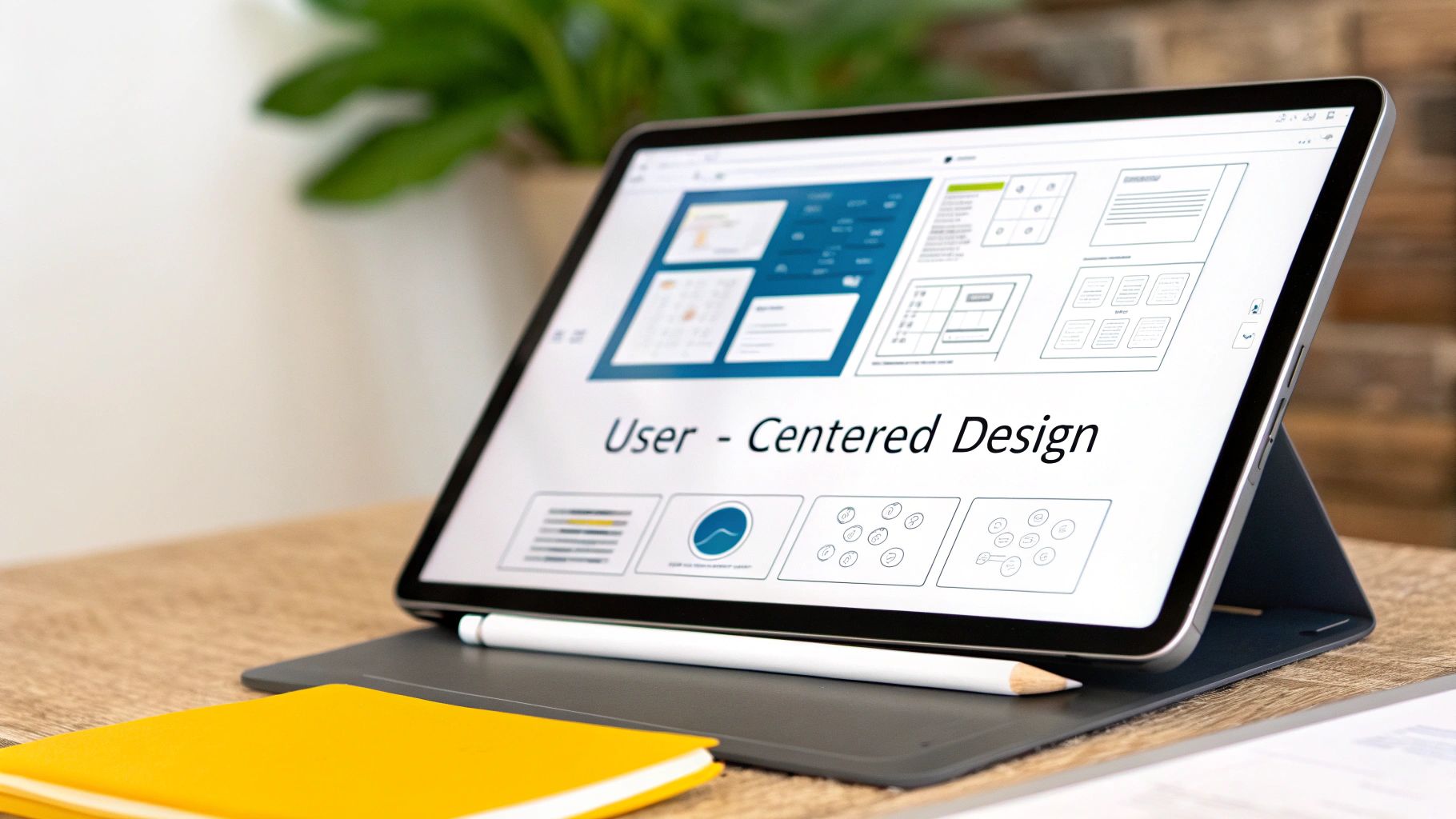Web Development for Startups: Essential Tips for Success

For any startup founder, your first website isn't just another box to check—it's your single most important investment. Think of it as your lead salesperson, your primary investor pitch deck, and your first handshake with the entire world. It has to be sharp, efficient, and convincing from the moment it goes live.
Why Your First Website Is Your Most Important Hire
Imagine an employee who works 24/7 without a break. That’s your website. It’s out there attracting customers, validating your business idea, and building credibility while you're busy running the company. But get it wrong, and that same website becomes your biggest headache, piling up technical debt that kills your momentum and turns away the very people you need to impress.
Making the right technology and design decisions from the start is non-negotiable. I've seen too many founders learn the hard way that a polished, user-friendly site isn't a "nice-to-have." It’s the bedrock of trust for your first users and investors. A solid web presence is your launchpad for grabbing market share and preparing for future growth.
Credibility and That Crucial First Impression
In a market flooded with new companies every day, your website is your primary tool for proving you’re the real deal. A professional, quick, and bug-free experience instantly tells visitors you're a serious business they can rely on. On the flip side, a slow, confusing, or broken site can kill your reputation before you’ve even had a chance to state your case.
Your website is often the one and only chance you get to make a good impression. It takes a visitor a mere 50 milliseconds to decide if they like your site enough to stick around or if they’re hitting the back button.
A Powerful Sales and Marketing Engine
Your website needs to be built with a purpose. It's not a static digital brochure; it's an active engine for generating leads and driving sales. Every single element, from your headline to the contact form, should be designed to move a visitor toward a specific, valuable action.
Here’s what your site should be doing for you:
- Capturing Leads: Use clear calls-to-action (CTAs) to get people to sign up for your newsletter, request a demo, or book a meeting.
- Educating Users: Your site must immediately answer two questions: "What problem do you solve?" and "Why are you the best choice?"
- Driving Conversions: Create simple, intuitive paths that make it ridiculously easy for a visitor to become a paying customer.
The battle for attention online is fierce. By 2023, a staggering 98% of small businesses had a website, and with about 252,000 new sites launching every single day, just existing isn't enough. Your site has to stand out. If you're figuring out how to get this done, our guide on hiring developers for a startup can help you build the right team from day one.
Startup Website Priorities at a Glance
To cut through the noise, it's helpful to have a clear roadmap. This table breaks down the core pillars every startup should build its initial web presence on for a solid foundation.
| Focus Area | Why It Matters for Startups | Example Action |
|---|---|---|
| User Experience (UX) | A smooth, intuitive journey builds trust and encourages users to convert. | Design a simple, clear navigation menu and a checkout process with minimal steps. |
| Performance & Speed | A slow site frustrates users and hurts your search engine rankings. | Optimize images and choose a reliable hosting provider like Vercel. |
| Clear Value Proposition | Visitors need to "get it" in seconds or they will leave. | Write a compelling headline on your homepage that explains exactly what you do. |
| Lead Generation | Your site must actively work to build your customer base. | Place a "Request a Demo" button prominently above the fold. |
Ultimately, these aren't just technical details; they are fundamental business strategies. Getting them right from the start puts you on a trajectory for sustainable growth and success.
From Napkin Sketch to a Viable Product

It’s a classic startup story: a brilliant idea scribbled on a napkin over coffee. But that's just the beginning. I've seen too many founders fall into the trap of rushing straight into development, fueled by pure excitement. This is one of the most expensive mistakes you can make.
The real magic happens before a single line of code is written. This is your discovery phase—the strategic work of turning a vision into a focused, buildable plan. It's about figuring out what’s truly essential versus what’s just a “nice-to-have” that will bleed your budget and push back your launch. Your goal is to define a Minimum Viable Product (MVP) that solves a real problem for a specific group of people.
Defining Your Minimum Viable Product
Let's clear something up. An MVP isn't a buggy or half-baked product. It’s the simplest, most stripped-down version of your idea that still delivers real value to your first users. It’s your ticket to getting into the market quickly, gathering feedback from actual customers, and iterating based on data, not just your own assumptions.
To nail down your MVP, get brutally honest with yourself by asking a few key questions:
- What's the #1 problem I'm solving? Get specific. "Helping businesses grow" is vague. "Helping Shopify store owners recover abandoned carts with automated texts" is a powerful, focused problem statement.
- Who is my first, ideal customer? You can't be everything to everyone, especially at the start. Pick a niche group of early adopters you can truly delight.
- What are the absolute, must-have features? Brainstorm every feature you can imagine. Then, be ruthless and slash everything that isn't critical to solving that core problem for that initial user.
This exercise is all about subtraction. A lean, focused MVP is faster to build, easier to sell, and gives you the clearest signal on whether you’re on the path to product-market fit.
Understanding Your Users and Competitors
You can’t build a great product in a vacuum. Smart web development for startups is always rooted in a deep understanding of your future customers and the tools they’re already using. Don’t worry, this research doesn't need a massive budget.
Start by sizing up the competition. Find 3-5 of your main rivals and put their websites under the microscope. Look for answers to these questions:
- What are they promising their customers?
- Which features do they push to the forefront?
- What’s their onboarding experience like? Is it smooth or clunky?
- What do their customer reviews say?
Those negative reviews are pure gold. They show you exactly where the market has gaps—gaps your product can be designed to fill.
As you move from a basic idea to a functional product, direct user input is invaluable. Learning how to conduct user interviews effectively can guide your development and ensure you're building something people actually want.
Crafting Personas and Journey Maps
With your research in hand, it’s time to make your target user feel real. A user persona is essentially a fictional profile of your ideal customer. Give them a name, a role, and real-world struggles. For instance, meet "Marketing Maria," a 32-year-old manager at a B2B SaaS company who's frustrated by how hard it is to track campaign ROI. This simple character sketch keeps your entire team aligned and focused on who they're building for.
From there, you can chart out Maria's user journey. This is a visual map of her entire experience, from the moment she first hears about your product to the point where she becomes a happy, paying customer. It helps you spot potential roadblocks and design an experience that feels natural and intuitive every step of the way. This is how you transform that napkin sketch into a product with a real shot at success.
Choosing a Tech Stack That Grows With You

The technology you build your website on is far more than just a line item on a budget. It's a foundational business decision. Your tech stack will dictate how fast you can build, how much you’ll spend, and how easily you can adapt when your startup inevitably needs to pivot or scale.
Let's be honest, the sheer number of options is overwhelming. Every framework and language has its own army of devoted fans. The secret isn't finding the one "perfect" stack—it's about finding the right stack for your specific product, your team's skills, and your budget. Think of it as a strategic investment that needs to pay dividends as you grow.
Monolith vs. Microservices: A Real-World Breakdown
One of the first big architectural questions you'll hit is whether to build a monolith or go with microservices. Let's cut through the jargon. A monolith is a single, all-in-one application. Every feature—user logins, payments, notifications—is part of one interconnected codebase. This is much simpler to build and deploy at the beginning, a huge plus when speed is your main currency.
Microservices are the complete opposite. Imagine building a collection of small, independent services that talk to each other through APIs. Your payment service doesn't need to know how the notification service works; it just sends a message. This approach offers incredible flexibility and scalability later on, but it comes with a much steeper learning curve and higher complexity right out of the gate.
My Advice for Most Startups: Start with a monolith. It’s faster to get your MVP to market and infinitely easier to manage with a small team. You can always strategically break it apart into microservices later, once you have product-market fit and a clear idea of which parts of your system are under the most strain.
Picking the Right Framework Without Chasing Trends
Next, you have to choose your frameworks—tools like React, Vue, or Angular for the front end, and Node.js, Ruby on Rails, or Django for the back end. It's so easy to get sucked into what's hot on Hacker News. A much smarter approach is to evaluate them based on what matters to your business right now.
Ask yourself these questions:
- What does my team already know? The fastest way to build is to use the tools your team already masters. If your developers are Python wizards, choosing Django is a no-brainer compared to forcing everyone to learn a new ecosystem from scratch.
- How big is the talent pool? When it's time to hire your next developer, you'll thank yourself for picking a technology with a large, active community. Frameworks like React have a massive talent pool, making it far easier to scale your team.
- What's the long-term vision? To make sure your site can handle growth without crumbling, it helps to be well-versed in mastering system design and architecture. This knowledge helps you make foundational choices that will support you for years to come.
The Startup Tech Stack Decision Framework
To help you weigh your options, I've put together this simple framework. It compares some common technology choices, helping you see the trade-offs based on key business and technical factors.
| Technology Type | Best For | Pros | Cons |
|---|---|---|---|
| Monolith (e.g., Rails, Django) | Startups needing speed-to-market; small teams; validating an MVP. | Faster initial development; simpler deployment and testing; unified codebase. | Can become complex to maintain as it grows; scaling is all-or-nothing. |
| Microservices (e.g., Node.js, Go) | Established companies; complex applications needing to scale specific parts. | Independent scaling and deployment; tech stack flexibility per service. | High initial complexity; requires mature DevOps; distributed system challenges. |
| JAMstack (e.g., Next.js, Gatsby) | Content-heavy sites, e-commerce, and marketing sites where performance is key. | Excellent performance and security; lower hosting costs; great SEO. | Can be complex for highly dynamic applications; relies on third-party services. |
| No-Code/Low-Code (e.g., Webflow, Bubble) | Non-technical founders; simple MVPs; internal tools and landing pages. | Extremely fast to build; very low cost to start; no coding required. | Limited scalability and customization; vendor lock-in; performance constraints. |
Ultimately, the best choice depends entirely on your context—your product's needs, your team's expertise, and your timeline. Don't just pick what's popular; pick what's practical for you.
Leaning into Performance with PWAs and Serverless
For a startup, every millisecond of page load time matters, and every dollar saved on server costs counts. Two powerful technologies that directly tackle these issues are Progressive Web Apps (PWAs) and serverless architecture.
PWAs give your website an app-like feel, enabling features like offline access and push notifications right from the browser. They deliver a native-app experience without the massive cost and effort of developing separate iOS and Android apps.
This approach is more than just a trend. The web development market is projected to hit USD 125.4 billion by 2030, with PWAs being the fastest-growing segment at an expected 14% compound annual growth rate. This isn't just a niche—it's a clear signal of where the industry is heading.
Serverless computing, powered by platforms like AWS Lambda or Vercel Functions, lets you run code without ever thinking about managing a server. You only pay for the exact compute time you use, which can dramatically slash infrastructure costs for a startup with unpredictable traffic. It’s the ultimate pay-as-you-go model, perfectly suited for a lean budget.
The Build vs. Buy vs. Partner Decision

You’ve defined your MVP and have a tech stack in mind. Now for the million-dollar question every founder faces, especially with a limited runway: who is actually going to build this thing? This isn't just a simple choice; it's a major fork in the road that will directly shape your budget, timeline, and how much control you have over your product's destiny.
This is about more than just finding someone to write code. It’s about securing the right kind of expertise to turn your vision into a real, market-ready product. You essentially have three paths: building an in-house team, buying a pre-made solution, or partnering with external experts. Each comes with serious trade-offs.
Path 1: Building Your Own Team
Hiring your own developers gives you the ultimate level of control. This team lives and breathes your product every single day, becoming fully invested in your mission. Over time, they build up priceless institutional knowledge, and you can pivot on a dime without having to renegotiate contracts.
The catch? This is almost always the most expensive and slowest way to get started. Finding and hiring top-tier engineering talent is a brutal, competitive sport. On top of steep salaries, you have to factor in benefits, equipment, and management overhead. For an early-stage startup, this can easily burn through your precious capital before you even have a product to show for it.
Path 2: Partnering with Experts
This is where you bring in the specialists—either a full-service development agency like Nerdify or a curated team of freelancers. This approach offers a powerful mix of speed and seasoned expertise without the long-term financial burden of hiring.
An agency gives you instant access to a well-oiled machine: a coordinated team of designers, developers, and project managers who have launched products hundreds of times. They bring battle-tested processes and a valuable outside perspective that can challenge your assumptions in the best way possible. It’s a fantastic route when you need a high-quality product launched quickly and reliably.
Freelancers offer more flexibility and can be perfect for smaller, well-defined tasks. You can essentially assemble a "dream team" for a specific project. The main challenge here is management. You become the project manager, and coordinating everyone can quickly turn into a full-time job.
A word of warning: success with any external partner hinges on absolute clarity. A fuzzy, poorly defined project is destined for delays and budget overruns. Before you even think about engaging someone, you must how to define project scope to get everyone perfectly aligned on goals and deliverables.
Path 3: Buying an Off-the-Shelf Solution
The "buy" option usually means using no-code or low-code platforms like Webflow or Bubble, or even purchasing a white-label product you can slap your brand on. This is, without a doubt, the fastest and cheapest way to get a functional product out the door. For simple concepts or internal tools, it can be a brilliant way to test an idea with minimal risk.
The trade-off, however, is a major lack of flexibility and scalability. You are fundamentally stuck within the boundaries of the platform. As your business grows, you will almost certainly hit a wall where you can't build a crucial feature or integrate with a vital service. This vendor lock-in can force you into a costly and painful migration down the road.
Making the Right Choice for Your Startup
There’s no magic formula here. The best path is completely dependent on your startup's specific stage, funding, and core objectives.
Here’s a practical way to frame the decision:
- Build: Go this route if your core product is deeply technical, you've secured significant funding, and you have the luxury of time to recruit an A-team.
- Partner: This is the sweet spot for most startups. It perfectly balances speed, quality, and cost, getting you to market fast with a professional product while you focus on the business.
- Buy: Use this for validating a very simple idea or launching a basic landing page. Think of it as a temporary first step, not the long-term foundation for your business.
For most founders, a partnership model is the ideal launchpad for web development for startups. It lets you tap into elite talent from day one, dodge the heavy overhead of an in-house team, and get your product into the hands of customers—which is where the real learning always begins.
Designing a Website That Actually Converts

It’s an easy trap to fall into. You pour your heart and soul into a beautiful, sleek website, but it’s just not bringing in sign-ups, sales, or leads. At that point, it's nothing more than a very expensive digital business card. This is where we need to shift our thinking from just building a website to designing one that actively works for your business.
The real art of designing for conversion isn't about flashy animations or secret growth hacks. It's grounded in psychology, absolute clarity, and a relentless focus on removing friction for your users. Good web development for startups means every single design choice—from a button color to a headline—is made with one question in mind: "Does this guide the user toward our most important goal?"
Creating Intuitive User Flows
A user flow is simply the path a visitor takes on your site to get something done, whether that’s buying a product or signing up for your newsletter. The best user flows are completely invisible. They’re so intuitive that the user never has to stop and think about what to do next. It just feels right.
Think about it. When your ideal customer lands on your homepage, what is the single most important action you want them to take? Your entire page should be engineered to steer them toward that one outcome. This means crystal-clear headlines, logical navigation, and visual cues that create a kind of "yellow brick road" leading straight to the conversion point.
The Power of Clear Calls-to-Action
Your Call-to-Action (CTA) is easily the most important button on your website. It's the final gate between a curious visitor and a new customer. And yet, I see so many startups cripple their own efforts with vague, uninspired CTAs like "Submit" or "Learn More."
Your CTA copy needs to be specific and action-oriented. It has to clearly state the value the user gets by clicking it.
Instead of: "Get Started"
Try: "Start My 14-Day Free Trial"
Instead of: "Subscribe"
Try: "Join 5,000+ Founders Weekly"
These stronger examples set clear expectations and create a sense of benefit, making the click feel like a no-brainer.
Your website's design is fundamentally about communication. The goal is to eliminate any and all confusion. If a visitor has to stop and wonder what to do next, you've introduced friction—and that's often all it takes for them to leave.
Core Conversion Tools, Not Afterthoughts
In the chaotic rush to launch, critical elements like mobile design, page speed, and accessibility often get pushed to the back burner. This is a huge mistake. For any modern startup, these aren't just "nice-to-haves"—they are foundational conversion tools.
A slow website is a conversion killer. Seriously. A delay of just 100 milliseconds in load time can slash conversion rates by 7%. For a new startup, that's a devastating loss of early adopters and revenue.
And with over 60% of all website traffic now coming from mobile, a "mobile-first" approach isn't optional. It's essential. This means you design for the smallest screen first and then adapt the design for larger screens. It ensures the experience is perfect for the majority of your users, not an awkward, pinched-and-zoomed afterthought. To dive deeper, our guide on how to increase website conversions is packed with more strategies.
Finally, web accessibility ensures that people with disabilities can use your site. Not only is this the right thing to do, but it also opens up your market and has the added benefit of improving your site’s overall usability and SEO. Smart, inclusive design isn't just good karma; it translates directly to a healthier bottom line.
Launching is Just the Beginning: Learning and Scaling for the Long Haul
Hitting that "go live" button is a massive moment—definitely one to celebrate. But it’s not the finish line. In my experience, it's actually the starting gun for the real race. This is where the work truly begins, separating the startups that thrive from those that fizzle out.
The whole game post-launch is about creating a tight feedback loop: you launch something, you see how real people react to it, and then you scale what works. This simple cycle pulls you away from building based on gut feelings and assumptions and pushes you toward making smart, data-driven improvements. Every decision—from new features to marketing spend—is guided by real insights. That’s how you build a resilient platform that can grow with you.
Build, Measure, Learn: Putting the Loop into Practice
You've probably heard of the "build, measure, learn" loop from lean startup circles. It’s not just a buzzword; it’s a blueprint for your website’s evolution.
After you build and launch, your immediate next move is to measure. And I don't mean just tracking vanity metrics like page views. I’m talking about key performance indicators (KPIs) that tell you if you're actually getting closer to your business goals.
Once that data starts rolling in, you learn from it. Are people even clicking on that shiny new feature? Is there a specific spot in your signup form where everyone gives up? This feedback, whether from analytics or straight from a user’s mouth, is gold. It tells you exactly what to fix or what to build next, which kicks off the whole cycle again.
Setting Up to Measure What Matters
To get meaningful data, you need the right tools in place from day one. Seriously, don't put this off. Setting up analytics after your big launch-day traffic spike is a massive missed opportunity.
Here are the absolute essentials I recommend:
- Web Analytics: Tools like Google Analytics or the privacy-focused Plausible Analytics are non-negotiable. They show you who is visiting, where they came from, and how they navigate your site.
- Heatmaps & Session Recordings: I love services like Hotjar or FullStory for this. Watching a session recording is like looking over a user’s shoulder—it's the fastest way I know to spot confusing design or broken elements.
- Performance Monitoring: Keep a close eye on your site speed and uptime. A slow or broken site kills credibility and sends potential customers running.
The startups that win are obsessive learners. They are constantly digging into user behavior and using that knowledge to make their product better, week after week. Think of your website as your primary laboratory for these experiments.
Once you launch, you need to make sure search engines can find you. A great website no one discovers is just a file on a server. It's critical to learn how to increase your Google crawl rate and get indexed faster so your first customers can actually find their way to you.
Is Your Infrastructure Ready for Success?
Picture this: your startup gets a shoutout in a major publication or a post goes viral. A dream come true, right? It can quickly become a nightmare if that sudden flood of traffic takes your site down.
A crashed website during your moment in the spotlight is a disaster. It doesn't just cost you a ton of potential customers; it seriously damages your reputation. This is why planning for scale isn't an over-optimization—it's just smart risk management.
Startups are already under incredible pressure, with about 1 in 5 failing within their first year. The ones that succeed almost always have a solid technical foundation. As of 2025, over 1,200 startups globally have reached "unicorn" status, and you can bet their digital presence played a huge role. A robust platform signals market readiness and helps attract the investment needed to grow. You can find more insights on the current state of the startup ecosystem on explodingtopics.com.
Smart Scaling Strategies
You don't need to build a system for millions of users on day one—that's a waste of money. But you absolutely need a plan for growth.
Here’s a practical approach to preparing for scale without breaking the bank:
- Pick a Scalable Host: Go with a cloud provider like AWS, Google Cloud, or a modern platform like Vercel. They make it easy to add more resources, often automatically, as traffic spikes.
- Use a Content Delivery Network (CDN): A CDN is a game-changer. It caches copies of your assets (images, code) on servers worldwide, making your site load incredibly fast for everyone and taking a huge strain off your main server.
- Keep Your Database Lean: As you collect user data, your database can become a major bottleneck. Make it a habit to review and optimize your queries to keep them running fast.
- Implement Caching: Caching is your friend. It stores frequently requested data in a temporary, high-speed layer so your server doesn't have to do the same work over and over. This frees it up to handle more users.
By obsessively listening to your users and building on a smart, scalable foundation, your website becomes more than just a digital brochure. It becomes the engine that powers your startup's growth for years to come.